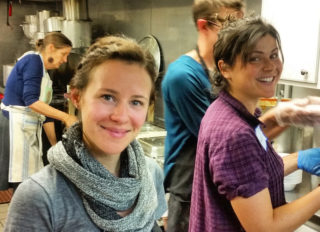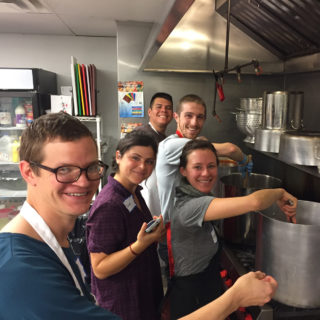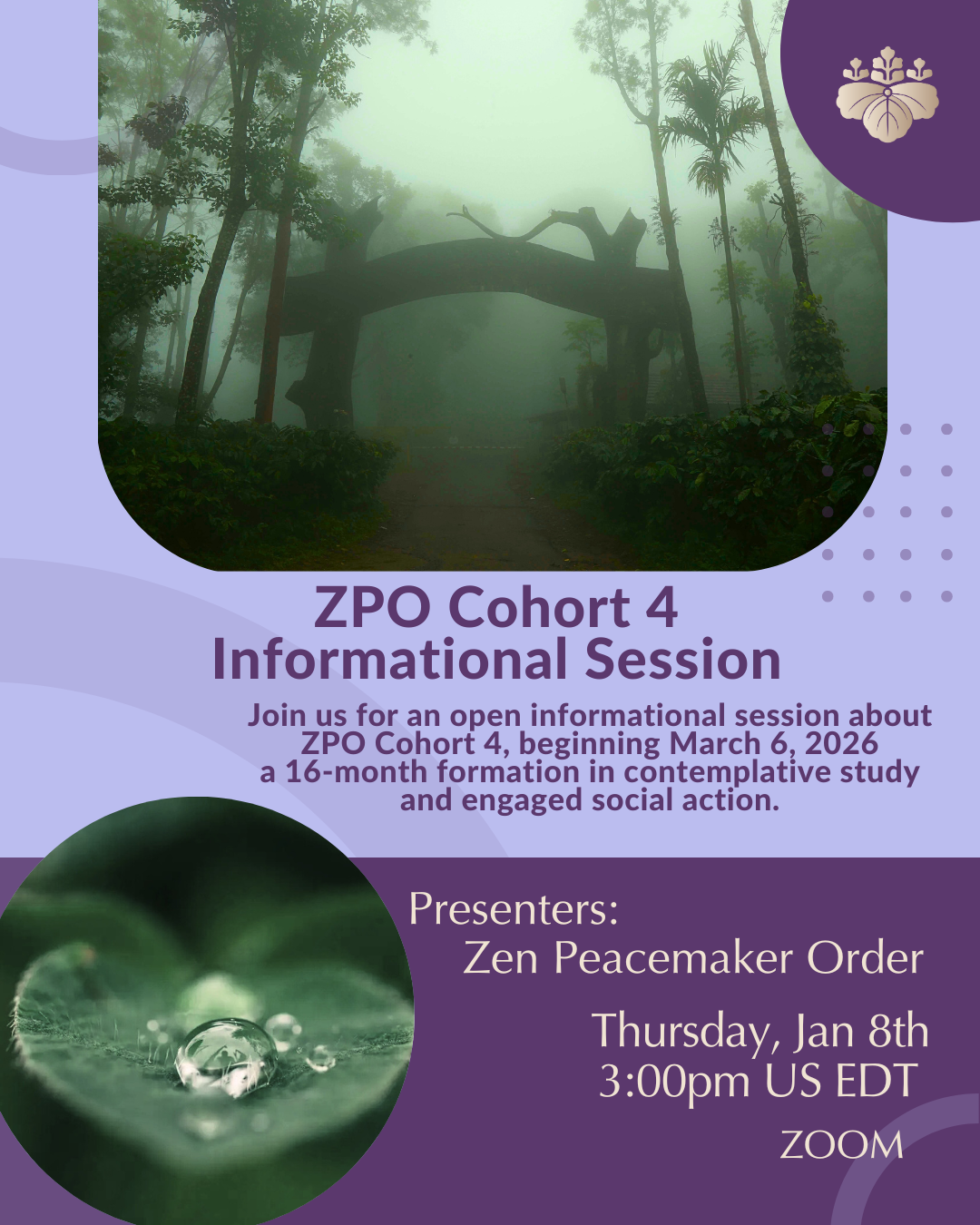by Cassie Moore, Upaya Resident
“Calling all you hungry hearts
All the lost and left behind
Gather ’round and share this meal
Your joy and sorrow
I make it mine.”
—from The Gate of Sweet Nectar liturgy
SANTA FE, NEW MEXICO, USA. Most nights, people line up outside of the Santa Fe homeless shelter, Pete’s Place, well before the glass doors stretch open for dinner at 6 p.m. For dozens of people, “Pete’s” (formerly the Pete’s Pets building on Cerrillos Road in Santa Fe, now the Interfaith Community Shelter) is a winter emergency shelter that offers nourishment and beds, as well as community and safety.
To serve meals, the shelter relies on legions of volunteers, like us. A Upaya team of eight, we’ve come dressed not in our usual Zenblack, but in “normal” clothes. We unpack a Subaru full of prepped veggies, spices, oils, and kitchenware and lug it all into Pete’s kitchen. Debbie who works at the shelter greets us with boundless energy, and orients us on how to prepare dinner, how to serve, and when to sit to join the shelter guests for dinner.
Over several days, we have been preparing for this dinner with the help of local sangha members. Our menu feels like a pre-Thanksgiving feast for the 105 people who will fill Pete’s dining hall tonight.
As we unload the car in trips, walking back and forth through the parking lot, we pass a dozen people looking in through the still-locked glass doors, pacing outside, resting on the sidewalk, catching up, smoking. A sangha volunteer whispers to me, “This is where I get shy.” Internally, I feel an old shyness fog me, too. I feel intense waves of differentiation coming up, noticing the clients who appear to be on drugs, seeing a group of women yelling in the parking lot corner. A man in the lot catcalls me. I notice this feeling arise that says, These people are different than me. I feel self-doubt. I’m afraid I don’t know how to show up with these people, that our differences are too big for us to connect, that I won’t know the right thing to say or do.
As we settle in, the kitchen begins smelling like holidays: it’s snowing out and our chicken soup and chili are in massive pots on the gas stove, roasted sweet potatoes and green beans are steaming, homemade ranch dressing intrigues the dinner guests lining up to be served, fresh bread will soak up their soup, and towers of brownies made by our local sangha members delight almost everyone—from the 9-year-old girl who is too shy to request one, to the oldest man, teeth missing.
During an unusually cold winter in 2005, 25 people died in Santa Fe from hypothermia and this birthed a local-led initiative for a winter emergency shelter. Those who come to Pete’s are only a fraction of Santa Fe’s homeless: In 2014 the New Mexico Coalition to End Homelessness estimated there is around 1,400 homeless in Santa Fe. Pete’s is the only shelter in town that allows non-sober guests to spend the night.
In one view, coming to Pete’s for one night and serving food feels miniscule. What about systemic oppression? What about systemic poverty? What about luck and circumstance, and how it seems some people are set up for homelessness? What do we do about that?! And in light of that massive problem, what is one dinner for one night? In that headspace, sitting on a cushion can seem like a vapid waste of time, and focusing on “nonaction” in favor of relationship can seem petty. In that space, fear and frenzy feel paramount.
The philosopher Jiddu Krishnamurti wrote, “Action has meaning only in relationship. Without understanding relationship, action on any level will only bring conflict. The understanding of relationships is infinitely more important than the search for any plan of action.” This aligns, of course, with Bernie Glassman’s Bearing Witness Practice, and Street Retreat, in which participants sleep on sidewalks, beg for food and eat at homeless shelters. In line with that philosophy, this dinner would be about connecting, and listening, and we hoped it would be free of delusions about “fixing.”
The line forms, and we begin serving. A young man my age has snow curled up on his shoulders. He says, “You guys look a l’il different than most [volunteer] groups.”
“What’d’ya mean?” I ask.
“Oh, I dunno,” he gets shy. “Just different.”
I snuggle a brownie against his salad, and catch his chili from falling off his full, warm plate.
“Ah,” I say, and we nod and smile. I begin to feel at home in my body, at home with my ability to relate, and I begin to trust again the hugeness of relationship, and how meaningful a moment can be. The dinner guests are grateful and kind. We relish in the huge size of the brownies our sangha made to share with them, we talk about how delicious Ranch dressing is—tiny meaningless things hold weight and are an avenue for connection, and love. A woman shares that she worries about the two little girls standing outside with their—her words—“cracked out” mother. “They don’t have coats,” she says, looking teary-eyed toward the snow.
I’ve an older brother who has schizophrenia. When we were children, he was violent and planted one of my first seeds of terror. Medicated, he is gentle and foggy. I remember him at his worst states, when police cuffed and jailed him after he put a knife to my neck, or beat my mother with an iron rod—I see him now as a person who was once racked with uncontrollable states of violence because his mind offers a convincing violent reality. At Pete’s, I look around and wonder, Would he be sitting across from me right now if he didn’t happen to have our mother to urge him through social services to be medicated and stabilized? Would he be a lot worse off, in a place a lot less safe? If circumstances where different (and they could so easily be different) would I know where he slept? Would I know if he were alive?
As I think of my brother who could so easily be here or in much more dangerous places, and in the silent exchange of serving each person and having a genuine moment with them each, the differentiating mind I noted in the parking lot when we arrived dissipates. I feel an ease come over me. In every face, I recognize something that has scratched at my own heart: hunger, gratitude, exhaustion, shyness, goofiness, pride, vulnerability.
Another Upaya resident steps in the serving line to give me time to sit down to eat with guests. As I sit, a mother and her two tiny girls are just leaving the table. They are nine and six, shy, wide-eyed with cub-bear eyes and long hair. They walked in from the snow without coats, their sweater sleeves soaked. Before she yanks them from the table, their mom yells at them to hurry up eating their brownies “or else.” I feel a collapse. What is their reality? What is this feeling of helplessness that I cannot fold them in a hug and protect them from a world that feels too-harsh-too soon? Hello, discomfort. Hello, helplessness.
What is sitting with the reality that the world cannot be fixed with a hug, that suffering is a part of us that is not going away no matter how sick of it we are? What is Bearing Witness really and how much strength and grace does it require—because my impulse seeing those girls and imagining their lives is to think, This is too much, and turn toward something lighter, or give up, or maybe worse, try to do something before I’ve any idea how to do something skillful. Is my impulse to do something a bandaid more for me than anyone, to feel like I’m fixing something? Can the world be fixed? Should it be fixed? Why do I think I’m a fixer?
Our engagement at Pete’s brought questions that I’m still sitting with; I realize the ambiguity of life was never meant to be easy.
***
The day after the shelter dinner, on Marcy Street, I cross paths with a homeless man. We meet eyes, mid-crosswalk. We meet hearts somehow, too, in the crossing. I realize how unafraid of him I am. That feels new to me. I don’t mean I’m unafraid in a careless throwing-caution-to-the-wind manner; I’m aware of the wise discernment it requires to engage the world from a 5’2” female body. The man smiles. His long Santa beard moves with his smile, and I nod back as if it were a bow. This feels normal, humane—totally non-magic, but profound. As I walk on, I feel guilt like a cold metallic pearl grow in my gut: hello, shame. What does it mean that the ability to see my own face in a homeless person is a thing that, for me, feels new? This shame feels warranted. It’s not that I’ve ignored homelessness, not at all. It’s that I’ve othered it. I’ve not seen myself in it. I’ve seen myself as a fixer, as coming to meet it with the heart of a rescuer.
Suddenly this feels to me to be a brand of meanness, a sly and convincing story about helping which conceals a deep discomfort with suffering, and has at its root the fundamental belief that I am on a higher level than those who would need helping. I’ve distanced myself from suffering by believing I can help fix it. In no small way, this makes me sick to my stomach. It seems to me that “fixing” has been my delusional highway meant to transport me to the equally delusional land of Problem Solved. More than anything, it prevented me from seeing anything but difference between myself and someone living on the street.
In a 2015 film, the actor Richard Gere played a homeless man. Employing method acting, Gere lived on the streets for periods of time. He told Rolling Stones magazine how it was the only time since fame found him that he was ignored by people,“It wasn’t that folks didn’t notice me; they could see someone asking for change from two blocks away. It was that they saw the embodiment of failure — and failure is something that people fear will suck them in.”

The writer Michaela Haas called the turning away from America’s homeless as, “Out of sight out of heart.” That turn of phrase hits where it matters. Since the dinner at Pete’s, I have felt a kind of growing up that, at twenty-eight years old, has nothing to do with my age. It has to do with taking responsibility for recognizing, and then undoing, my conditioning which for me and I suspect for many of us, normalized the rotten and subtle art of othering.
This is what our Zen practice is about—being honest about our prejudices, taking note of our internal stickiness, confronting our conditioning, and uncovering an original and basic goodness that, when dusted off, enables us to actually see ourselves in another face by stepping back from the delusional belief in our separateness.
At the bottom of the homepage on Pete’s website, they list the names of shelter clients who died in 2015: “We remember you, who were one of us—the people of Pete’s Place…We remember your laughter, your tears, your friendship, your troubles. We remember something you said to us one day that eased our suffering, or made us giggle, or caused us to stop and see that we are truly kin.”
Twenty-four names are listed, ranging in age from 33 to a 72 year-old war veteran. At the end of the list of 24 names, there is an asterisk followed by the word “unknown,” signifying the deaths that remain unaccounted for. What does it mean when communities cannot name the people dying in their streets?
Sitting with this, I’m asking what my personal responsibility is. Sitting with discomfort and feelings of complicity in systemic injustice, I’m asking myself what it means to be a voyeur in a community, versus a member.
In an article on Bernie Glassman’s work with homelessness, the journalist Michaela Haas wrote, “We need to find ways of weaving our suffering into the tapestry of our lives, individually and as a community. We need to bravely explore a new relationship with pain and sorrow and ask where it fits in. We need to make room for it to fit in. Because it is already here. Shutting it out just means shutting ourselves in. Connecting with the homeless is the only way to bring them home.”
(originally appeared on Upaya Zen Center website)



